#praise Ostara
Text

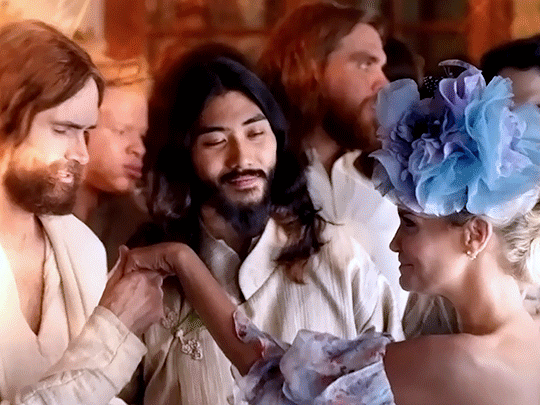

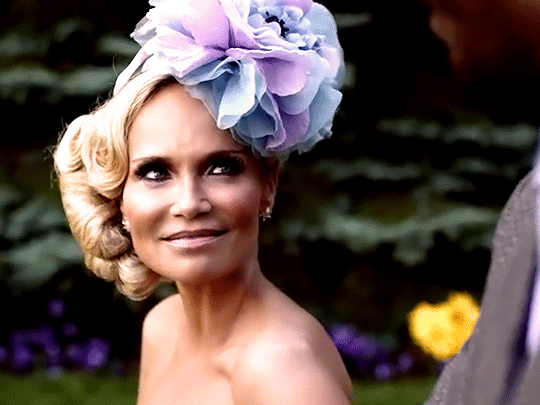
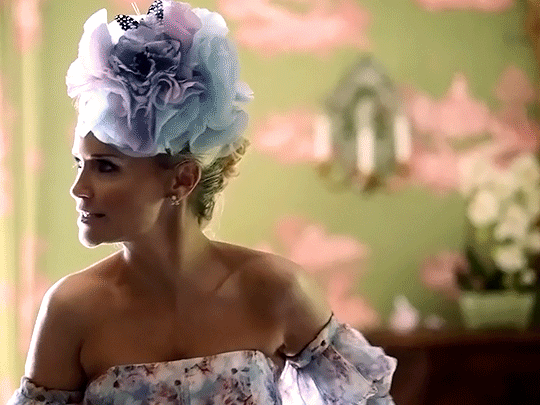





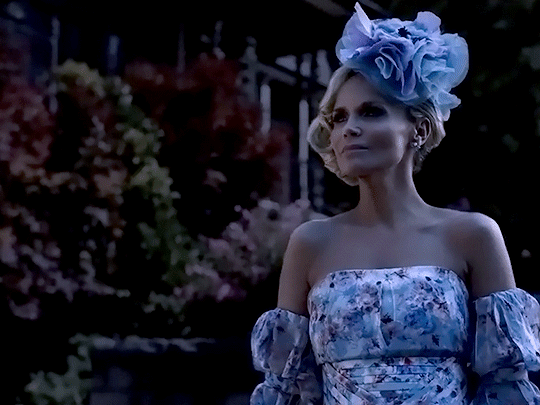
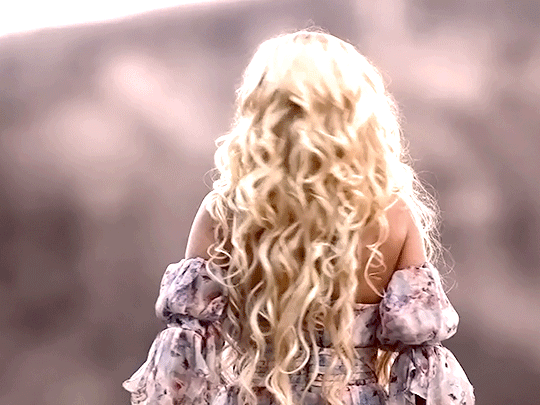
Ostara Happy Easter
American Gods - Come to Jesus
#kristin chenoweth#Ostara#Easter#American Gods#my gifs#tv edits#tv : Fantasy#tv : Dark Comedy#kcedits#Happy Easter#if that's your bag#it isn't mine so I'm celebrating the Gods I do Worship#Praise Ostara
97 notes
·
View notes
Text
Happy New Year!
Our Lady has gone down into that darkest place, has suffered and been broken, and She has triumphed! No soul shall be lost forever, no soul shall suffer in any eternal hell.
The world is fresh and new, reborn by Her Hand and flush with Divine Light and energy. And so today is the first day of spring, and also of a new year!
The Filianic Eastre is not dissimilar from its Christian (Easter) and neopagan (Ostara) counterparts, or from many springtime festivities around the world. Dancing, music, egg games & dyeing, flowers everywhere, and a big feast with plenty of dessert.
3344 (I.E.), is a year of Sai Thame, Janya of divine law and harmony. The year itself, as well as each month and week of the Filianic calendar will begin on Thamedi / Thursday, until next Eastre.
And the children of the earth cried: Lift up your voices in song and laughter, for the Princess of the World was dead and is alive again, was broken and is whole; and there is no place whereto Her joyous rule does not extend. Give praise to the Mother of All Things and praise to Her Daughter.
Rejoice, for the world is renewed.

#deanism#filianism#déanism#deanic holidays#goddess religion#vernal equinox#spring#spring equinox#The clear recital#Eastre
18 notes
·
View notes
Text
Ostara and the Hare
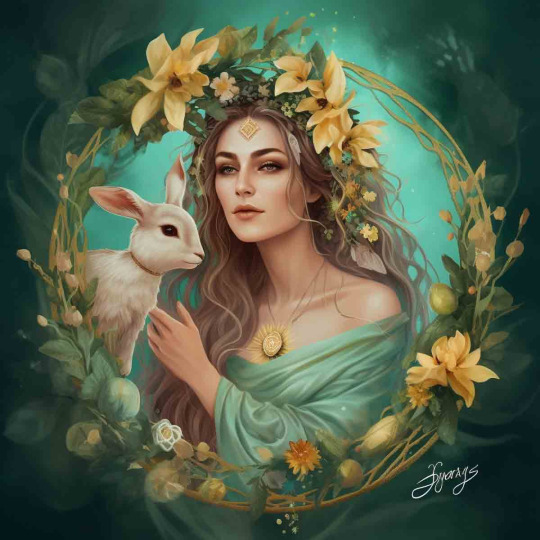
The spring equinox is right around the corner! It's called Ostara on the Wiccan wheel, and it's one of my favourite holidays. The colours, the rainbows, the eggs, the flowers, the food; it is the embodiment of spring. There's just lots of fresh, new, albeit young energy everywhere.
But this post is not focusing on Ostara the Celebration. This is focusing on the story of Ostara and a Rabbit. It seems to be a German folktale from the late 1700s to early 1800s that was spread via word of mouth. The name Ostara comes from Eostre, Goddess of spring. Spring is all about beginnings, fertility, rebirth; so it's not surprising to see a folktale that combines symbols of these things catch on and be retold.
A little fun note about the story, the Gender of the Hare is never made clear. He is referred to as male, using He/Him pronouns in most stories (which I will continue to do) but he is able to lay eggs; something traditionally reserved for females in old folktales. It's mostly written off as a glitch in the magic, but maybe he is intersex? I dunno, but it's a little fun to think about.
Ostara and the Hare
One year, the winter was particularly long and harsh. The snow was deep, the air was cold, and the Goddess of Spring, Ostara, was late.
When she finally arrived, the animals and people were so thankful to see her. Her presence thawed the land; trees could start budding, and animals came out of hibernation and hiding to frolic. Soon, the sound of song birds could be heard singing as they flew around looking for a new love.
Ostara smiled as she looked across the land. As creatures passed her by, they always stopped to offer their praise and thanks. This pleased the Goddess Ostara, and she promised she'll stay until spring is in full swing. The animals rejoiced at her assurance and gave her many gifts to show gratitude.
Then, a lone bird approached Ostara, walking up to her on land. His feathers had been damaged from the long frost and he could not fly. He looked ragged and exhausted. The happiness and energy that reached the other animals did not seem to affect him.
"My Goddess, Ostara. I come to you with a request." the bird kept his head low and his tone respectful, "Your power is great and I ask you use that power to change me into a Hare."
"A Hare?" Ostara looked confused, "You do not wish to live your life as a bird?"
"Every year, winter is long and harsh." The bird explained, "I can do nothing but huddle in my nest and try to keep warm. But I see the Hares move about easily in the snow, kept warm by their fur. My feathers can not endure another winter like the last." Ostara looked the bird over, and indeed his feathers did not seem suited for an icy winter. She agreed and used her powers to turn the bird into a Hare, like he asked.
"Go now." she spoke once the transformation was finished, "Live your life as a humble, but warm, Hare." When he realized he was now a Hare, he leapt high into the air cheering for joy. But when he landed, something strange happened. In his excitement, he laid an egg.
The egg was a pretty sky blue with green pokadots. An egg unlike anything ever seen before. Ostara looked at it, enthralled. The Hare picked up his decorative egg and offered it to Ostara. She took it with great enthusiasm and the Hare hopped off.
Word of the Hare blessed by Ostara started to spread fast. Animals and creatures from all over came to him, wanting to see the colourful eggs. Each time he laid an egg, they came out different and unique. Everyone loved to see and receive his eggs, and he in turn loved the new attention he got.
After some time went by, Ostara noticed a change in the forest. Despite spring continuing to come, the praise and thanks she got from the creatures stopped. All animals, from birds to deer to mice, would pass by and not stop to acknowledge her. They all seemed focused on where they were going. Curious, Ostara followed them one day.
All the animals were going to see the Hare and his eggs. She watched while hidden. The Hare would hop and lay a new, colourful egg. Dozens of coloured eggs surround him with impressive vibrancy and intricate patterns. Ostara looked at the egg the Hare has given her earlier, and was annoyed how simple and plain it looked in comparison.
The creatures cheered as the Hare made more eggs and handed them out. "You are amazing!" a squirrel praised, "How do you do it?" Ostara, knowing his colourful egg laying ability was made possible because of her powers, thought maybe now she'll get the credit and praise she was deserved. But the Hare stood high and mighty as he answered "I just imagine the colours, then I hop and pop! Nothing to it."
Ostara was furious. How dare he not only take all the attention of spring away from her, but also take all the credit for a gift she gave. Add to that, he had not shared with her the more beautiful eggs he could now make. Ostara made her outrage known as she reveled herself and berated the Hare. She told him to gather every egg he had made. She was going to take him and every egg he made away, forever.
The Hare begged Ostara not to make him take all of his eggs back. The eggs brought so much joy to everyone who received them. To take them away would take away their happiness. Ostara agreed that the eggs could stay, but he would need to come with her when she leaves at the end of spring.
And so the Hare left with her. Ostara promised she'd be back again next year. And at the end of every winter, she indeed makes her return to bring spring. During this time, she allows the Hare to return for a single day. For one day, he is allowed to share his bright and colourful eggs that are known to bring so much happiness. Sometimes they are in plain sight, and sometimes they are hidden. Can you find one?
#food and folklore#fairytale#folktale#folklore#pagan#witch#eggs#Ostara#spring#easter#hare#rabbit#bunny#easter bunny#goddess#klickwitch#wiccan#intersex
10 notes
·
View notes
Text
The feast day of Easter was first a pagan holiday of renewal and rebirth. Honored in the early spring, it praised the pagan goddess of fertility and spring known as 'Ostara', 'Eastre' or 'Eostre'. The word “Easter” finds its etymology from the goddess's name, and the eggs and rabbits we use today are symbols of fertility and birth.

8 notes
·
View notes
Text
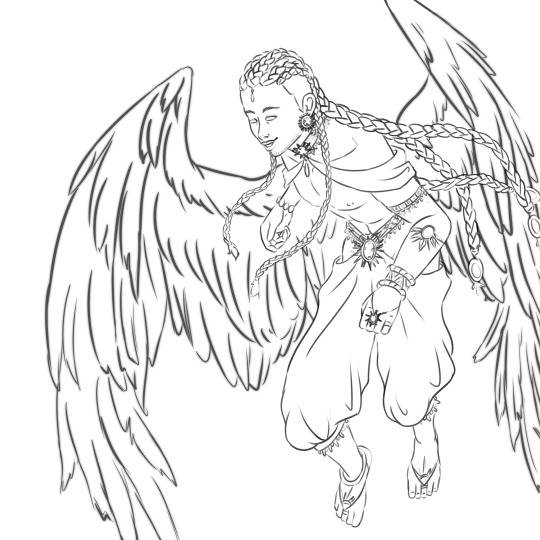

Praise up to Ostara, Life-bringer, Lord Of The Gentle Dawn, god of Spring, patron deity of medicine, childbirth, and mothers
Aka more of that classic move "fanart for an AU that doesn't make any sense because I haven't written it yet."
#One Piece#Marco The Phoenix#Reincarnate au#god au#He works for Nika!#I was gonna draw his wings on fire but then I didn't want to#I was also gonna do a bunch of lighting effects but then I didn't want to do that either#so have this
7 notes
·
View notes
Text
about me: FAQ my practice
I have been holding off on answering many of my Asks as they relate to this post. Hopefully, this answers many of the questions sent my way! this is a really long post, but it's good info about me!
Introduction
What name do you go by in your practice? Kate
How long have you been practicing? about 8 years, since 2015-2016
Path and Tradition
What type(s) of witchcraft do you practice (e.g., Green Witch, Eclectic Witch, etc.)? I primarily stick with kitchen, green, and solitary witch, however, I am really drawn to the practice and idea of speaking and working with the dead and kind entities.
Do you follow a specific tradition or path? If so, which one? I am religious in addition to my practice as I follow a Christian faith. I utilize this in my practice having a deity to talk to as well as ask for blessings from, etc etc. I give offerings of time and energy more often than physical gift offerings.
Beliefs and Ethics
What are your core beliefs or principles in your practice? Simply do no harm, since I have an underlying religious belief that what needs to be taken care of will be taken care of. (such as if someone wrongs me, I don't need to do anything, my deity, the Christian God will or the universe will get everything all sorted). And I just don't like retaliating my energy in that way when I have way better uses.
Do you follow any ethical guidelines or rules (e.g., Wiccan Rede, Threefold Law, personal code of ethics)? I guess the Christian code of ethics + my own adjustments to them bc some takes are wonky.
Deities and Spirits
Do you work with any deities, spirits, or other entities? If so, who are they? The Christian God, but I would love to work with the dead or other kind entities since I believe in spirits. I don't work with my ancestors though.
How do you honor or communicate with them? through praise and time, prayer, and reading the Bible.
Tools and Materials
What tools are essential to your practice (e.g., athame, wand, crystals)? cup of water, a candle, and a bowl of salt!!! I now live in an apartment where candles aren't allowed so it's just been the water, salt, and a spicy oil (to simulate fire).
What materials do you commonly use (e.g., herbs, candles, oils)? oils, herbs/spices, (no more candles...:(( ), salt, water, teas (not counted as herbs bc most herbs I use otherwise are for throwing into the air or something witchy I don't know it's complicated, tea is specifically for brewing and consuming.
Rituals and Ceremonies
What regular rituals or ceremonies do you perform (e.g., Sabbats, Esbats, daily rituals)? BATH RITUALS omg my favorite, I think I made a post about this somewhere on my page, if I can find the ritual template I'll link it here. otherwise, I am a wh*** for Sabbat rituals, specifically Litha, Beltane, Samhain, and Yule, but I love them all tbh esp when Ostara lines up on the Christian holidays and I don't have to explain why I'm extra giddy.
Describe a typical ritual or ceremony you perform: a lot of it is cooking, like I just look insane like I'm dramatically cooking dinner or something. otherwise, there are usually hella candles that I can't have in this apartment and so much salt and herbs, and my journal (grimoire/BoS)
Spellwork
What types of spells do you commonly cast? usually something like a personal or home protection spell (short and long-term ones, and for the long ones, the renewals of them), wards, and refreshers of them, but also spells for "anti-" migraines and other headaches since I struggle with multiple types of chronic headaches.
Describe your process for creating and casting a spell. I usually use candles (not indoors anymore) spell jars or a food dish of some sort that has corresponding elements to the task/intention at hand
Divination
What forms of divination do you use (e.g., tarot, runes, scrying)? I only tarot right now, scrying can be really draining for me and trigger my migraines.
How do you integrate divination into your practice? I use tarot once daily whenever I have free time or if have a specific question to ask or when I want to try out a new spread (usually the case)
Nature and Elements
How do you incorporate nature and the elements into your practice? I use herbs and spices primarily, if I can find them fresh in the wild (I live in the city, so that's rare), then I will use those (not to eat) in my spells. I usually get stuff store-bought. But I have been looking for good trails and parks in the area since we moved an hour from where we lived during college. I want to get a local field guide and find some cool plants, mushrooms, animals, and things while out on the trails. My husband says he is eager to go on walks, and I am too ADHD to walk without something to do so looking for plants and animals/birds would be so fun.
Do you have a special connection to certain natural places or elements? I feel like I belong somewhere rainy with no bugs... (no fresh cut grass since I'm allergic), I unfortunately have a strong fear of bugs (thanks dad).
Astrology and Cosmic Influences
How do you use astrology or cosmic events in your practice? I don't use a ton of true astrology, but I pay attention to the moon, the sun, and the planets as they are currently, but not as they relate to me or others in my daily life and practice. This next question explains it a bit further.
Do you follow moon phases, planetary transits, or other celestial influences? I usually do a moon phase bath on the high points of each turn (new, first, full, third) to reset for the new week. For planetary transits, of course, we all know mercury retrograde, however, I like to journal at every point, whether highs or lows to see which point I'm being affected the most, see if it is mundane or mystical. I have a calendar specific for these days, and I like to map out what my "tasks" are for the week or month.
Sacred Space
Describe your sacred space or altar. I have a physical altar on my dresser in front of my dresser mirror, but also a cute tech altar on my computer, and most of my resources and books and stuff for information are digital so having a digital/tech altar allows me to have quick access to any info I may need.
How do you create and maintain this space? My dresser can sometimes get cluttered but usually, it's easy to clean up. My computer altar just needs a bit of organization occasionally when files get to be too much. I normally do y workings all over the place however I use many of the same elements in all workings which allows for the continuity of my altars.
Personal Development
How do you continue learning and growing in your practice? I love to learn. If I hear something new, I will spend so much time trying to learn as much about it as I can. Sometimes, I don't resonate with it for my practice, but I enjoy knowing about it. I am by no means an advanced practitioner, so I still have so much to learn.
Do you keep a Book of Shadows or a journal? If so, what do you document? I do, I journal my daily events, thoughts, etc. I also take note of most of my research and all of my workings to look back on. If I have odd dreams, I will write down those as much as I can remember. If I have a weird experience, I will explain that in my journal for future reference, sometimes, I think I get shown omens of sorts, but who knows!
Community and Coven
Are you part of a coven or magical community? No, not at this time. I work alone. I am involved in a couple Discord servers that are like groupchats for a lot of practitioners around the globe. Sometimes, I get so busy with school, work, and home life that I don't interact there often.
How do you interact with or contribute to this community? I interact with mutuals on Tumblr and Discord and occasionally run into people who will comment on my accessories/jewelry that spark further conversation opening up about our practices.
Challenges and Goals
What challenges have you faced in your practice? Since I practice alone primarily, I have noticed that I have a lack of close-by practitioners to lean on for suggestions, information, meetings, etc. Like when I say I practice alone, I mean I don't conduct workings with the help of additional witches or practitioners in the form of a coven or group. I do find interest in friends or groups with other individuals who are practicing.
What goals do you have for your future practice? To feel more comfortable in my craft without aid rather than using ritual/spell aids as I sometimes forget the steps or wording I've written since I sometimes have gaps in my workings due to my schedule.
Let me know what other questions you guys have!
#queue the magick#witchcraft#witch#magickkate#witchblr#kitchen witch#reference#green witch#witchy#about me#frequently asked questions#faq#my practice#witches#witch aesthetic#witch community#witchcraft 101#witchcore#witch tips#witch blog#witches of tumblr#witchcraft community#witchy shit#witchyvibes#witchtok#interview with the vampire
5 notes
·
View notes
Note
Hey! Not a request, but a question. I have christian family, and therefore, I am going to be attending the Easter festival that my family hosts every year. I wasn't able to celebrate Ostara properly this year, and was wondering if there was any other way that I can celebrate and praise the deities on Easter? Thank you so much!
I follow the Irish fire festivals which doesn't include Ostara (which has a little bit of a shady history) so I'm not ~the best~ person to ask, but generally speaking it marks the Spring Equinox (the point in the spring when the period of day and night are equal) and the general vibe is to acknowledge and welcome spring/growing.
So my personal suggestion is to find something that represents growth to you (maybe you can get your family to plant wildflowers or something like that?) and work that into your activities, but otherwise just enjoy the food and family! Most fire festivals (while they do have their ritual components) focus on getting everyone together and feasting, building community and ties with those around you, I see no reason this holiday should be treated any differently.
4 notes
·
View notes
Text

Praise to the Spring, Praise to all living things
Praise to the Maiden and the joy that she brings
Praise to the Earth let all her creatures now sing
Hope is renewed with the coming of the Spring
- Ostara - Lisa Thiel [X]
The spring equinox is here :) What are your plans?
13 notes
·
View notes
Photo

MARCH by William Cullen Bryant (1794-1878) The stormy March is come at last, With wind, and cloud, and changing skies, I hear the rushing of the blast, That through the snowy valley flies. Ah, passing few are they who speak, Wild stormy month! in praise of thee; Yet, though thy winds are loud and bleak, Thou art a welcome month to me. For thou, to northern lands, again The glad and glorious sun dost bring, And thou hast joined the gentle train And wear’st the gentle name of Spring. And, in thy reign of blast and storm, Smiles many a long, bright, sunny day, When the changed winds are soft and warm, And heaven puts on the blue of May. Then sing aloud the gushing rills And the full springs, from frost set free, That, brightly leaping down the hills, Are just set out to meet the sea. The year’s departing beauty hides Of wintry storms the sullen threat; But in thy sternest frown abides A look of kindly promise yet. Thou bring’st the hope of those calm skies, And that soft time of sunny showers, When the wide bloom, on earth that lies, Seems of a brighter world than ours. #hellomarch #march1st #marchblessings #march #marchpoetry #marchmadness #poems #poem #poetic #poet #poetry #poems #poetryofinstagram #classicpoetry #Spiritique #mindfulness #Spiritual #Spirituality #mystical #mystique #mystic #mysticisim #spring #springseason #springsummer #summer #summerseason #summerrains #ostara #springequinox #blessedbe https://www.instagram.com/p/CpNoEXVyEij/?igshid=NGJjMDIxMWI=
#hellomarch#march1st#marchblessings#march#marchpoetry#marchmadness#poems#poem#poetic#poet#poetry#poetryofinstagram#classicpoetry#spiritique#mindfulness#spiritual#spirituality#mystical#mystique#mystic#mysticisim#spring#springseason#springsummer#summer#summerseason#summerrains#ostara#springequinox#blessedbe
9 notes
·
View notes
Text





Ostara Happy Easter
American Gods - Come to Jesus
#kristin chenoweth#Easter#Ostara#American Gods#my gifs#tv edits#tv : Fantasy#tv : dark comedy#kcedits#Happy Easter#if that's your bag#it isn't mine so I'm celebrating the gods I do worship#praise Ostara
34 notes
·
View notes
Text
Easter History And How To Enjoy Stress Free Easter
What is the meaning of Easter? It depends on the person and their own beliefs. To our family, it is simply a family holiday to enjoy together. We have fun with Easter baskets and egg hunts. But we have to understand where Easter originated to understand the meaning behind the traditions.
We like to teach our children the history of every holiday. If you follow me, you know that. No matter your beliefs, you need to know how holidays started and why they are apart of our lives.
The feast day of Easter was first a pagan holiday of renewal and rebirth. Spring is known as the season of new beginnings because it symbolizes the rebirth of nature and the return of life after the challenges of winter. The spring season brings back color, flowers, and animals that have been dormant during the winter. This is why it is celebrated throught the world and history.
Honored in the early spring, it praised the pagan goddess of fertility and spring known as ‘Ostara’, ‘Eastre’ or ‘Eostre’. The word “Easter” finds its etymology from the goddess’s name. The Germanic folk, known as the Teutons, worshiped pagan gods and goddesses and it’s believed that the origin of the Easter Bunny, hares and eggs can be dated back to the 13th century in Germany.
Eggs are used as fertility symbols. Drawings of Eostre often depict her holding a woven basket on her arm, and she would carry baskets filled with eggs to encourage fertility. Eggs and seedlings have long been considered a sign of new life in many cultures, and the tradition of putting eggs inside Easter baskets has both religious and cultural significance. Later on Christians would hold on to the old customs. That's the main reason why we still give baskets filled with goodies during this holiday. To Christians it represents Christ's reasuresction.
Easter baskets are fun! But remember, that children do not need a lot. It isn't Christmas nor a birthday. Some candy, a new swimsuit, flip-flops, sunglasses, and sidewalk chalk all they really need. That is it. Sometimes, I don't always add flip-flops or a swimsuit. It really depends on it they have outgrown their old ones. To make it more enjoyable, try doing a scavenger hunt for the baskets instead of just putting them out to be easily found. It's much more fun for the kids. I do this for St. Patrick's Day. Unfortunately, I forgot to write a post about it. I will have to remember for next year. No matter the holiday, scavenger hunts are so much fun.
Dying eggs does not have to be a hassle. I know that many have problems with peeling eggs no matter what you try. Here is a suggestion: Start eggs in already boiling water for 15 minutes. Put eggs in ice water right for 15 minutes. Dye the eggs and peel under running water when you are ready to eat. Many sites have wonderful ideas on easy egg dying activities that are fun and stress free.
Another thing. I used to be one of those moms that thought my kids needed a new outfit for every holiday, including Easter. They looks adorable but it isn't necessary. They most likely already have something great for Easter in their closets. There isn't a need for me to stress about this nor you.
Easter egg hunts are another amazing activity. Everyone knows how to do this. But you don't have to only put candy. You can add money or little toys. Unfortunately, we couldn't do it today because it's a rainy day out where we live but we are excited to do it next weekend.
Once we are able to throughly enjoy Easter when the weather is better, I will add pictures. The kids are most excited about banana pudding. Remember, that desserts and dinner don't have to be hard either. Simply things such as puddings, no bake cookies, deviled eggs, and simple baked chicken instead of something that takes most of the day is just fine. You are meant to spend time with your family not slave away in the kitchen.
Well, that is it. Remember, that Easter is about the spring season and family fun. It doesn't have to be serious or hard by any means. Easter is filled with sunshine, warmth, lots of pastel and all the joy and new life that comes with spring!
0 notes
Text
Easter is associated with Christianity and to a pagan Spring festival that dates back long before Christ. The feast day of Easter was first a pagan holiday of renewal and rebirth. Honored in the early spring, it praised the pagan goddess of fertility and spring known as 'Ostara', 'Eastre' or 'Eostre' Christianity and the other flavors
0 notes
Text
16.3.2021 - Lazy witches + Ostara activities
I have not practiced my craft in a long time. It almost feels as though I have almost forgotten how I used to. Which is why I chose to reconnect with my magic by going for a long walk tomorrow, no distractions, just focussing.
Also I will spam my blog a bit with some posts about some witchy topics, especially about sabbaths and esbaths (Ostara’s coming up and I can’t wait!)
On that note, here are some things you can do (even in these times) to welcome the sun and life returning once more into the world.
Ostara is a pagan holiday dedicated to the germanic spring goddess “Ostara” (originally called Eostræ). Deities connected to this holiday are Freya or Osiris (Wiccan tradition).
The themes of this holiday, as you might have guessed, is renewal, growth, rebirth and new beginnings. There is a tradition in the neo-germanic paganism movement of Asatrú, which is a modern reinterpretation of the old nordic belief, where a fire is lit before sun sets, and it burns through the night to welcome the first long day of the coming summer. This night is often passed with celebrating with a small group of friends and/or family.
But as I like to have a collection of small, but meaningful activities and traditions, here is my list of things you can do for this year’s Ostara:
put order in your surroundings (and yes, that means do a spring-clean)
also cleanse on an energetic level; sage your space, open and clean the windows, let air and light stream into your space and yourself. Maybe grab a pan and a cooking-spoon to clank evil sprits the fuck outta your house!🥣
deal with overdue business, such that you have been pushing and postponing for some time. Get it done, you will feel so much better!💜
do candle-magic, maybe add some flowers into your spellwork
take care of your flowers and plants in your surroundings. They too are life that fills your space, by caring for them, your care for yourself.
bake or cook something that really excites you when you think about cooking it. Maybe prepare the food intentionally and practice some kitchen magic ( note: eggs and avocados are associated with birth and fertility )
toss crushed or grinded eggshells into the garden, your plants will love it as egg shells are a fantastic fertilizers
plant seeds for some herbs, you will harvest from them over the long run ( also it’s pretty damn awesome to watch things grow ☺️🌱 )
meditate
reflect on your aims for the future and on what you have achieved in the last year/month/semester. Be kind to yourself and praise your accomplishments
reconnect with nature. take a walk, leave nothing but footprints and take nothing but memories and what falls into your way.
fuck. celebrate your sexuality in your way, pleasure yourself, some other or others, but celebrate life and the way to create it. But, of course, only if you feel comfortable with it🔮
Light candles in your home, or light a fire ( but keep it safe! ) to attract light and life into your space.
103 notes
·
View notes
Text
Randivor has me by the throat and won’t let go. Romance-heavy smut under the cut.
_______
Everything Else
_______
Eivor couldn’t help but laugh. It wasn’t a sound she often heard coming from herself outside of mead-soaked feasts or on the heels of a successful raid. Even then, in halls filled with drunken friends and by riverbeds lined with fallen enemies, there was always an air of performance, a twinge of bold, fanged cruelty that came from victory.
Not tonight, though. Not with Randvi.
Their bedchamber was not a raised stage or a proving ground. There was no performance to be put on here.
Randvi’s touch was sharp, precise as a whetted blade splitting flesh. Where no blood spilled, a more delicate sensation lingered on Eivor’s scars. With muscles spent and nerves singed by a rush not unlike the storm of battle, Eivor could only gaze up at the ceiling. And laugh.
“What is it, my love?”
Eivor would never tire of this. Odin’s halls of glory were nothing to the glow of Randvi’s skin.
“Look up,” Eivor said. She pointed lazily. “There’s a face in the wood.”
Randvi settled the hand that had been tracing a tattoo on Eivor’s bare hip. Her palm burned against it as an ember.
“A face?” Randvi said, skeptical.
“Look,” Eivor repeated.
Careful to keep her head where it was on Eivor’s chest, Randvi glanced up. “Where?”
“Right above us. See the eyes and the mouth?”
“Is it meant to be frowning?”
“Hm. It does look displeased. I’m afraid I cannot empathize.”
Randvi pushed herself up on one elbow, taking her warmth with her. She stared down at Eivor, a smile playing at the corners of her lips. It was a familiar expression, one she could not resist making whenever Eivor arbitrated a ridiculous quarrel with a perfectly straight face. “Have you not noticed this face before?”
The dregs of a laugh caught in Eivor’s chest, rumbling deep and pleasant. “Sleeping in my own bed used to be more a privilege than an expectation.”
“Hm...” Randvi’s fingers trailed up to Eivor’s ribs. “Maybe you’re just spending more time on your back nowadays.”
Eivor’s breaking grin was interrupted swiftly. Randvi kissed her, long and full, the heat of her skin enough to melt tension that was already hours since dissolved.
“I am hardly opposed,” Eivor muttered.
Randvi’s hands betrayed no hurry - Ravensthorpe was well-stocked, thanks to recent river raids, and the Ostara Festival was coming to a close. Everyone was happy and drunk, off dancing until the sun came up and telling stories.
“Have you not had your fill for one night?” Eivor teased.
“We have many nights to make up for, darling.” Randvi’s mouth landed on the scarred line of Eivor’s throat. It was as a feather, tickling and tantalizing. “And I would expect Ravensthorpe's prized drengr to have more stamina.”
“Sweetness and salt, all at once,” Eivor prodded, head lolling back on a rumpled pillow. “You are a difficult woman to argue with.”
“Good.”
The woman with the wildling soul was pleased to reclaim her own freedoms. Time for exploration was something she treasured, she was already well-versed in traveling south.
Her gaze burned from between Eivor’s legs, twin blue flames as if the sky itself were alight. Eivor could let it consume her, she thought, and die breathless and content.
Randvi could hold her own in any fight, but she needed no blade to take a warrior apart.
When a shiver struck and made Eivor’s legs quake, Randvi did not miss it. “Who would have guessed the great Eivor Wolf-Kissed would fall to such a lightness?”
It was unusual, compared to how it had been with others. Strength was Eivor’s native language, something to strive for and admire. She’d always met opponents and lovers with the same shows of force.
But never Randvi. Hers was not an arena where power was proven with dominance.
Where drengrs roared and raised their fists, Randvi’s voice and hands were soft. Battles chewed steel and shattered bone, but this was a quiet and sure balm to the most harrowing of wounds unseen.
How amusing that Eivor knew she had wanted this for so long, yet she never minded when Randvi took her time.
Between gasps, Eivor asked, “Tell me - Randvi - when did you know?”
Randvi shifted as water, fingers flowing to where her mouth had barely left. “I know many things. You'll have to be more specific.” Her lips pressed together, shining into a smirk.
Eivor managed to think her question into form. “When did you know you wanted this?”
As the moon commanding a ruthlessly gentle tide, Randvi’s assured smile waned into softness. “I’ve always known, Eivor. Since the first moment I saw you. So hardened, so fierce. I wished to know what was underneath it all.”
“Oh? And so you - ah.” Bold to try and taunt from such a compromised and vulnerable position, but Eivor did not relent. “So you always wished to be as a dagger... to my sheath?”
Randvi paused - a warning. She sat upright, but her fingers remained still.
The way she regarded Eivor, as a wolf might a sheep - it sent sparks up the taut column of the sheep’s spine.
“A wise woman can make use of any tool, I think,” Randvi said finally. She knew she’d won the point even before her fingers dipped and curled, a flourish as graceful as a spinning silver sword.
Eivor’s back arched, and she was as a sheath, seeking. She conceded, “And wise you are.”
Fortunately, Randvi loved hearing such things, especially from Eivor, and it was a sure way to bring out a sly grin that thinly shielded a deceptively fragile part of her heart. If there was one thing Randvi deserved, it was praise. She’d gone unappreciated for too long - even a moment was a sin - and yet she never shied from her post at the heart of their town. It would never have become more than a pile of bricks and stray ships without her guidance.
“The oldest trees must envy you,” Eivor went on.
“Must they?”
Eivor would not have the chance to say more if Randvi was allowed to continue, the waves building. So Eivor sat up to see her face-to-face, pulling her into a narrow straddle and kissing her, first on the forehead.
“For all their years, you are sager,” Eivor said.
She took Randvi’s hand to her lips and kissed her palm.
“For all their strength, you hold firmer. And for all their roots,” one last lingering kiss over her heart, beating wild, sealed by the same steady, guided palm, “yours run deeper.”
Randvi said nothing for a moment, her expression one of pure, quiet awe. Then, she shook her head slowly, keeping her eyes on Eivor’s. “Your poet’s soul is a dangerous thing.”
Eivor took her by the waist, revering the way she could look up at this woman who put the staunchest, most resilient trees to shame. “Even so, when the possessor is in truth the one possessed?”
“Especially then, you minx.” Randvi bumped their noses together, a novel gesture that Eivor was suddenly very fond of.
“I am afraid I cannot offer an apology.”
Randvi was the one to initiate their next kiss, though it was as fleeting as a bird over a river. “It is a beautiful thing, my love. I would accept no apology for it.” Her voice grew stern as she continued. “But nor do I possess the possessor in question.”
Eivor needed only gesture to their position. “Ah, but you do have me, do you not?”
“Cheeky,” Randvi chastised. She poked the side of Eivor’s face for good measure, and her touch trailed down to the jaw. “If that is the frame, then you are mine only insofar as you are your own.”
“Then I am yours - and my own, and the Raven’s - entirely.”
Randvi hummed, considering this, playfully cryptic.
“Do you find these terms of alliance agreeable?” Eivor joked.
“Ah, is this how you made us so many friends?”
“Well, these Saxons are less stubborn with their bellies full of mead and their mouths full of--”
With a kiss, Randvi cut her off and confirmed their jest of a treaty.
“I have made but one pledge in this way,” Eivor said for the sake of clarity. “And it is to the woman I call my wife.”
Randvi would have embraced her again and sent them both toppling onto the bed furs, but Eivor held her rooted in place.
Eivor’s hand snuck between them, finding its purchase as Randvi settled and relaxed against honed callouses. She had no qualms with the roughness - quite the opposite, actually. They built a pace together, painstaking, but with all of agony’s antonyms. Randvi’s breaths came faster, shallower, as she clung to the unwound remnants of Eivor’s dark braids and a shaky imitation of control.
“I must ask you,” Randvi exhaled all at once.
“Anything,” Eivor interrupted.
“Tell me when you knew.”
“That is not a question.”
Randvi nipped at Eivor's neck - not wolf-kissed, this time, but something close. “Petulant.”
“When did I know, or when did the gods know?” Eivor asked. Rarely did she have such a perfect set of conditions to toy with the greatest strategist the snows had ever produced.
“Either. Both,” Randvi managed.
“I cannot speak for the gods.”
Randvi grasped at the smooth muscle of Eivor’s back, blunt nails scraping across the flat planes of her shoulder blades. Her breath came hot against Eivor’s ear, along with her next words: “When did you know you loved me?”
The drengr’s iron resolve to taunt and pester shattered, armor falling away to reveal the poet’s vulnerable heart.
“I must be honest, you were the faster study between us, Randvi,” Eivor began. “I could not name the thing that pulled me to you, even when it was like a vine around my marrow, so ingrained that I could not walk without feeling its tug.”
“More,” Randvi said. “Tell me more.”
“Everywhere I went, I heard the flowers sing of your beauty. The trees whispered about your wisdom. Great dark clouds and lightning proclaimed your unwavering strength and loyalty to all those you care for.”
Randvi said no words, but she was not quiet.
“And these were pieces, pieces - only fractured shards of a reflection.”
“Eivor...”
“I did not realize they were my own heart-thoughts the world had given voice...”
A barely stifled moan.
“Until the wind itself called me back to you.”
With that, a broken groan slipped from Randvi’s throat and her rigid fingers dug in, bruising, driven by the sheer desperation for release. Her purgatory lasted, fueled by a merciless hand, until - “Eivor!” - less a name than a surrender to catharsis.
Eivor was braced for the collapse, easily keeping Randvi from falling limp into their bed. Somewhere in Eivor’s mind, there was a witty crack brewing about stamina and poetry and how’s that for wisdom, but the peaceful flow of Randvi’s breathing as it steadied and deepened was too lovely to cut short.
Eventually, Randvi righted herself, every inch of her covered in a fresh, fine dew.
“And you thought I was fierce,” Eivor said. She started to brush a piece of sweat-stuck hair from Randvi’s forehead, but the distance between them vanished quickly.
Randvi was not capable of sloppiness in anything she did, but this - crashing their mouths together while still working to catch her own inhales - was the closest she ever came. “I stand by it,” Randvi sighed as she rested her forehead against Eivor’s.
“I’ve thought of another question for you,” said Eivor.
“Hm?”
“Are you trying to wake the whole town?”
Randvi’s laugh was a delicate wisp, but not lacking bite. “And just how many times have you cried my name tonight?”
“You assume I can count that high?”
“If either of us wakes the town tonight, it will be you, my love.” Her thumb stroked the sharp corner of Eivor’s jaw before another promising kiss. “And that is as much a threat as it is a vow.”
“So be it,” Eivor said, lying back, arms splayed freely by her head. “Let them know for whom their jarlskona bends the knee.”
***
[cross-posted on AO3]
#randivor#randvi x eivor#eivor x randvi#randivor fic#assassin's creed valhalla#acv#my writing#valhalla#if you saw me take this down and then repost it no you didn't<3#asscreed
48 notes
·
View notes
Text
Imagine spending Easter with Ostara.

Ostara’s place was always one of beauty, but on Easter, it really shined. It was your favorite day of the year because it was her day, one that she well deserved. None of the humans out there really understood what it was that Ostara did for them year after year, praising the wrong things. You tried to make up for that in your own worship of her.
“What are you doing, sitting in here?” You asked, noticing that she was in a room with an older man. “Your guests are waiting for you outside. It’s almost time for the egg hunt.”
“You’re right, I should be attending to my guests,” Ostera said, getting to her feet. There was a glint of silver from behind her as a sword fell onto the ground. The clattering sound broke her smile for just an instant, but then it came back full force. She approached you and took your arm, as she often did during this day, liking to have you close. “What would I do without you to keep me on schedule, sugar?”
“You’ve been doing this for years without me. I’m just happy to share in the responsibility.”
She leaned in and pressed a kiss against her cheek, her light pink lipstick leaving a trace of a smear that you would wear proudly through the proceedings of her special day.
Requested by: Anonymous
#Ostera#Ostera x reader#Ostera imagines#Easter#Easter x reader#Easter imagines#American Gods#American Gods imagines#request#imagines
25 notes
·
View notes
Text
The eight Sabbats: Witch's holidays

by Michelle Gruben
Modern Pagans celebrate eight major holidays throughout the year, known as Sabbats. They are based on pre-Christian customs related to the movement of the sun. Most are related to the Celtic agricultural festivals that have given them their names.
Of course, now we know that the sun doesn’t actually move around the earth. And lots of Pagans live far away from the places where our food is grown. But the Sabbats are still a meaningful way to connect with the cycles of the seasons and of human life.
The Pagan Sabbats include the four astronomical holidays (the equinoxes and solstices) and four traditional holidays in between. Together, these eight festivals are known as the Wheel of the Year. They are observed in Wicca and Wicca-influenced forms of neo-Paganism.
Learn about the eight Witch’s holidays and some popular customs for each one:
Samhain
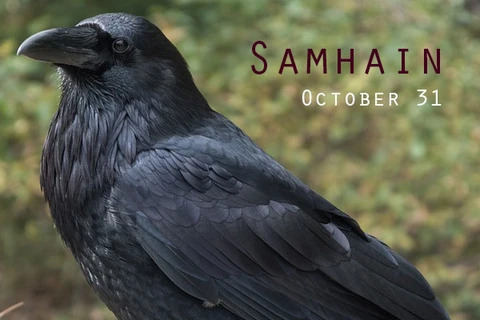
Probably the best-known of the Sabbats, Samhain is celebrated on October 31st. It coincides with Halloween or All Hallows Eve. Halloween is a time when even non-magickal people indulge in spooky activities and ancient superstitions. It's also the time when mainstream culture pays the most attention to the activities of Witches and Pagans.
The word Samhain comes from the Irish Gaelic word for “summer’s end.” The days have become shorter, and the darker half of the solar year is upon us. At this time, farmers would use up the remaining stores of perishable fruits and vegetables, preserving other foods to sustain them through the cold and dark season. They would also slaughter any livestock that they did not plan to feed through the winter. This is why we sometimes refer to Samhain as the Third Harvest, or Blood Harvest.
At Samhain, many people believe the boundary between the words is at its thinnest. Samhain is also known as Ancestor’s Night or the Feast of the Dead. For most Witches, Samhain is the best time to commune with the beloved dead (ancestors and honored spirits). Some also believe that lonely or angry spirits may wander the Earth on Samhain night, looking for humans to annoy.
How Pagans celebrate: For Pagans, Samhain is the beginning of the new year. It is a holiday of reflection and celebration. At Samhain, we cast off the old year’s attachments and turn our attention to the coming scarcity of winter. We feast on the last of summer’s bounty. We contemplate what is worth saving and nurturing during the dark of winter. We try to make friends with Death.
Pagans celebrate Samhain in many of the same ways muggles do: Scarfing down sweets, carving jack-o-lanterns, dressing up in costumes. We decorate with skulls and spiders and go to haunted houses. All of these Halloween traditions are too fun to miss out on—and besides, most of them have their roots in old Pagan beliefs, anyway.
If you’re invited to a Samhain ritual, you may see an ancestor altar. This is a shared altar where participants are invited to pile on their mementos and offerings for the dead. The presiding priest or priestess may invoke a deity who rules over transitions or the migration of souls—Morrighan, Hecate, or Hermes. You may participate in a meditation where you travel into the depths of the underworld, or look departed friends in the eye once more. People will speak the names of loved ones who died during the previous year, or long ago.
Feasting is a component of many Samhain rituals. When we eat sweets, we are savoring the sweetness of life and its impermanence. When we eat meat, we remember that all flesh must die and become nourishment for some creature or another.
We also use food as an offering to the dead—to communicate fond memories, to pay our respects—and perhaps, to appease hungry ghosts. Some Pagans set an extra plate at the Samhain table for spirit visitors. Another contemporary Pagan custom is the “dumb supper”—a silent meal where we invite our ancestors (both known and unknown) to come and dine with us.
Yule

Yule is the Pagan name for the Winter Solstice, the longest night of the year. In the Northern Hemisphere, it falls on or around December 21.
After the winter solstice, the darkest part of the year is over and the days begin increasing in length. This solar holiday is related historically to Christmas—Pagans delight in pointing out that Christians co-opted the date around the third century CE.
In the overarching neo-Pagan mythos, Yule is the birthday of the divine infant who is conceived in the spring. The dark of midwinter is the period of the Goddess’s confinement and labor as she prepares to welcome the solar child. On the longest night, the Sun God is born to the praise and gratitude of all Earth’s creatures.
How Pagans celebrate:
Yuletide is a time for passive, personal magick—for short days of work and long nights of dreaming. We set intentions and incubate our plans. It is a time of preparing mentally and spiritually for the light half of the year. Some Pagans keep a midwinter vigil, awaiting the rebirth of the sun at dawn.
It’s not often that you find large group rituals for Yule—probably because lots of Pagans are busy traveling and visiting with non-Pagan family! Instead, Yule rituals tend toward the home-y and conventional.
We decorate with evergreens and holly. We exchange gifts with friends and family. On Midwinter Eve, we light candles to herald the return of the sun. (The ambitious among us may set a Yule log blazing.) We eat traditional, calorie-rich holiday foods: Tamales, eggnog, rum cake, ham, and chocolate. We give thanks for the life-giving energy of our planet’s sun.
Imbolc

Imbolc is a festival of purification and the early signs of spring. Imbolc is celebrated on Feb 1. (Not yet spring in most of the world, to be sure—but sometimes spring-like in Britain due to the warming influence of the Gulf Stream.) It is the first of the three Pagan fertility festivals, followed by Ostara and Beltane.
In Old Irish, Imbolc means “in the belly” and was associated with the onset of the lambing season. It was an obscure Irish folk festival until the 20th century, when neo-Pagans revived it as part of the Wheel of the Year. It coincides with the Christian festival of Candlemas and with that old farmer’s oracle, Groundhog’s Day, both observed on Feb. 2.
For our ancestors, the significance of Imbolc would have been the beginning of the ground thaw. It is the time to prepare for the planting season—to survey the land, take an inventory of tools, and make any repairs or modifications that will be needed. For the Witch, it also a time of preparation. We clean and bless our altars, and make sure that the tools of our practice are attuned to their intended use.
Mythically, Imbolc celebrates the awakening of the Goddess after giving birth to the young God at Yule. In the Earth, we observe the first stirrings of life after the frozen winter. (If you don’t know what a frozen winter looks like, ask your grandmother.) Imbolc brings the energy of creativity and imagination. Projects that were put on hold during the holiday season start to creak into motion again. Our midwinter dreams resolve themselves into their first visible shapes.
How Pagans celebrate:
Imbolc is especially sacred to Brigid—Celtic Goddess of hearthfire, healing, the bardic arts, and smithwork. Many Imbolc rituals honor Brigid with candlelight, poems, and woven ornaments known as Brigid’s crosses. The first light of spring is evident by now, and it is an auspicious time of year for rites of cleansing, healing, and blessing.
Imbolc is a time for spiritual dedication and re-dedication. Some covens—especially women’s covens—initiate new members at Imbolc. For old Pagans, it is also a time to examine and refresh our practice. If we have become lax, Imbolc is an opportunity to purify our intentions and reconnect with spiritual guides. We light candles, open windows, and wash the floors to cast out the last gloom of winter. Some also use Imbolc for divination for the year’s harvest.
Imbolc is not really a feasting holiday, as the season of grains and fruits is months away. The first food of the year is dairy. Butter, milk, and cream are traditional foods for the Imbolc table.
Ostara

Ostara is the spring equinox, which falls on or about March 21 in the Northern Hemisphere. It is opposite the autumn equinox (which Pagans refer to as Mabon). But any desktop calendar can tell you that. Ostara is the Pagan cousin of the Easter holiday, a modern revival of one or more ancient spring celebrations.
Ostara is the second of three fertility festivals, a time when the blessings of spring become more visible in the natural world. Flowers bloom, the birds and the bees do their thing, and grocery aisles fill up with pastel-colored treats. Ancient fertility symbols like eggs and bunnies are everywhere. (Yep, Ostara is the Sabbat with the rabbit!)
Astronomically speaking, Ostara is a midpoint of the year, and day and night are equal at this time. The Sun God (who has been growing and gathering strength since Yule) is an adolescent. The Great Goddess, who has been getting progressively younger since December 21, is in her maiden form. These two lusty youths are now the same age, and will soon conceive the child who will be born at Yule.
How Pagans celebrate:
The original meaning of Ostara as a fertility festival is not lost on modern Pagans. Ostara provides a perfect opportunity to work magick for love, prosperity, and gains of any kind. We harness the energy of the lengthening days to fuel our desires and bring projects to fruition. We honor the gifts of the earth Goddess, who is presently blessing the land with beauty and nourishment.
Pagans also use Ostara as a time to reflect on the principle of balance. Everyone has goals and responsibilities—work, family, art, spirituality—that compete for our time and attention. At Ostara, we take a moment to notice things that may have shifted out of balance. We reset our priorities as the austerity of winter gives way to the exuberance of spring.
Beltane

Beltane is the ancient name for the May Day rite, held on May 1. Originally a fire festival, it was widely celebrated in pre-Christian Ireland and Scotland. The name comes from the god Bel (“the bright one”) and means “Bel’s fire.” It is the second of two principle festivals on the Celtic Pagan calendar, the other one being Samhain. Samhain and Beltane are the two poles of the magickal year, when the gates to Faery and the spirit world are most open to travelers.
In traditional Wicca, Beltane is a sexual festival, the last of the three fertility festivals. It is the time when the Maiden Goddess takes a lover in the form of the young God. Wiccans enact this drama through the ritual marriage (Great Rite) of a High Priestess and High Priest, whose union will bless the land.
How Pagans celebrate:
Theoretically, Beltane is an occasion of unbridled sensuality and revelry. However, sexual rites are rare in modern covens. If invited to a Beltane ritual, you’re far more likely to dance around a maypole or witness a symbolic Great Rite (with a chalice and athame) than encounter an orgy.
For the social Pagan, Beltane season abounds with bonfires, festivals, concerts, and campouts. Solitary Pagans might celebrate by making an altar to the young God and Goddess or connecting with a lover. Flowers, honey, sweets and wine on the altar echo the sweetness of the occasion. Beltane is also a time for illusion, seduction, and Faery tricks. By the light of the Beltane fire, the real can become unreal (and vice versa).
Since Beltane celebrates the union of the God and Goddess, it is a popular time for proposals, handfastings, and renewing of vows. Magickally, the combined masculine and feminine energies lend a powerful alchemical surge to almost any type of spellwork.
Litha
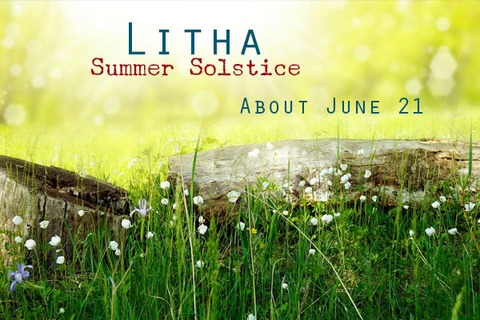
Litha is the summer solstice, which in the Northern Hemisphere falls on or about June 21. Linguists disagree about the origin of the Sabbat’s name, but summer festivals were common across pre-Christian Europe. People lit bonfires to keep the sun’s light alive for as long as possible. Solstice revels were supposed to bless the crops in the fields and drive away evil spirits.
Litha is the day when the Sun God is at the peak of his power. It is an auspicious day, ruled by the Sun and the element of Fire. After Litha, the nights will begin to grow longer and the Sun will move further away each day. With the fall harvest imminent, Litha is an opportunity for anticipating the (actual or symbolic) crop. Medieval people believed that Midsummer Night was blessed, and that whatever a person dreamed on this night would come true.
How Pagans celebrate:
Outdoor rituals are common at Litha, as Pagans take advantage of the long hours of daylight. It is a joyful Sabbat. Bonfires and summer games brighten the space between earth and sky. We decorate our altars with solar symbols, and honor the God in his aspect as Father.
Litha is an appropriate time for all magick ruled by the Sun. This includes spells of cleansing, protection, charisma, and truth.
Lammas
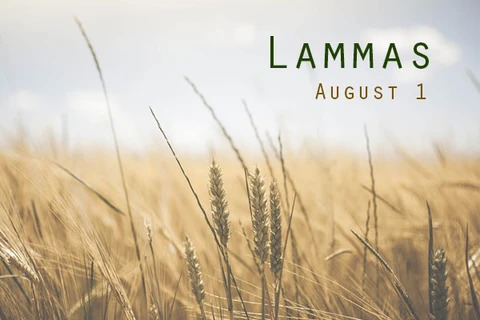
Lammas is the first harvest festival on the Pagan calendar, observed on or about August 1. It is related to an old agricultural holiday celebrating the reaping of grain. Lammas probably comes from the Old English words for “loaf mass.” Loaves of freshly baked bread would have been prepared from the first grain and blessed in churches around the countryside. Lammas is also called Lughnasadh, after the Celtic sun God, Lugh.
As the summer stretches on and the days grow shorter, the sun God symbolically loses some of his strength. He is not yet dead, but is aware that the dark season will soon approach. The god of summer “dies” in the fields to nourish the people, and prepares for rebirth at Yule.
How Pagans celebrate:
Lammas is a time to welcome the harvest. We give thanks that the year’s work is proceeding as planned, and that we will soon enjoy the fruits of our labor. Grain is the traditional food for the Lammas table, in the form of wheat, barley, beers and ales.
Celtic Pagans celebrate Lammas/Lughnasadh as the feast of Lugh, an agricultural god—but also a patron of poets, musicians, and craftspeople. At Lammas, we may show off the skills we have acquired and trade them for things we will need. It is a traditional time of year for craft fairs and local markets.
Mabon

Mabon is the autumn equinox (or as us Texans call, it “fawwwl”). In the Northern Hemisphere, it falls around Sept 21. Mabon is the pivot point of the solar year when the days begin to shorten and winter is on its way. (The name of the festival is modern and dates from the 1960s or early 1970s.)
Mabon may also be called the Second Harvest, because it is the time when autumn fruits and nuts reach their maturity. It is a time to contemplate what we have worked for in the previous year and what rewards we are ready to reap. We give thanks to the waning sunlight and prepare to store our wealth away for the scarce season. We shift from active to contemplative magick. Mabon season is a fine time for workings of prosperity, gratitude, security, and balance.
How Pagans celebrate:
Mabon is a time for celebration after the hard work of the harvest. Though it is sad to watch the beauty of the growing season fade away, we revel in the mild weather and rest that autumn brings.
Mabon foods are comfort foods, those that evoke fond memories and connect us through sharing. We bake and brew, pickle and can. Offerings of wine, cider, fruits, and boughs may adorn the Mabon table—along with that most Pagan of centerpieces, the Cornucopia.
On the Pagan religious calendar, Mabon represents the turning point to the dark half of the year. We shift our attention from the youthful merriment of the summer Sabbats. At Mabon, we honor the Crone and Sage deities, the cycles of aging and death, and the spirit world.
Mabon is a popular time for large outdoor rituals—in part because the weather is good and it doesn’t conflict with any major mainstream holidays. We gather together to feast and express gratitude for our lovely tilted planet. Many cities host a public Mabon ritual as part of their annual Pagan Pride Day gatherings. Solitary Pagans might celebrate Mabon with offerings at a home altar, or a contemplative walk in the woods.
https://www.groveandgrotto.com/blogs/articles/the-eight-sabbats-witchs-holidays
4 notes
·
View notes